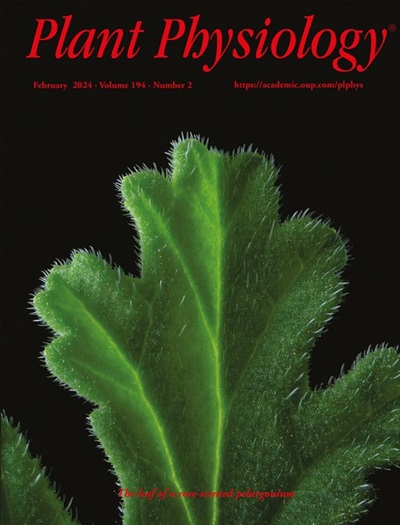The histone deacetylase RhHDA15 represses petal senescence by epigenetically regulating reactive oxygen species homeostasis in rose
IF 6.5
1区 生物学
Q1 PLANT SCIENCES
引用次数: 0
Abstract
Epigenetic modifications play vital roles in many biological processes. Flower senescence involves epigenetic factors that influence the chromatin state and gene expression. However, the molecular mechanism underlying the role of histone deacetylation in regulating flower senescence has not been elucidated. Here, we demonstrate that histone deacetylation is involved in flower senescence by fine-tuning reactive oxygen species (ROS) homeostasis in rose (Rosa hybrida). Our data reveal that the histone lysine deacetyltransferase RhHDA15 inhibits ROS accumulation and petal senescence by downregulating the expression of NADPH OXIDASE/RESPIRATORY BURST OXIDASE HOMOLOG (RhRboh) genes. Furthermore, the transcription factor RELATED TO ABI3/VP1 2 (RhRAV2) recruits RhHDA15 and the co-repressor TOPLESS (RhTPL) to suppress flower senescence by reducing H3 lysine 9 acetylation (H3K9ac) at the RhRbohA1/2 promoter and thus directly inhibiting precocious RhRbohA1/2 expression. Our work sheds light on an epigenetic mechanism in which histone deacetylation plays a crucial role in controlling petal senescence by precisely fine-tuning ROS homeostasis, providing insights into the regulatory network of organ senescence.组蛋白去乙酰化酶 RhHDA15 通过表观遗传调节玫瑰的活性氧平衡来抑制花瓣衰老
表观遗传修饰在许多生物过程中发挥着重要作用。花卉衰老涉及影响染色质状态和基因表达的表观遗传因素。然而,组蛋白去乙酰化在调控花朵衰老中作用的分子机制尚未阐明。在这里,我们证明组蛋白去乙酰化通过微调玫瑰(Rosa hybrida)的活性氧平衡参与了花的衰老。我们的数据显示,组蛋白赖氨酸去乙酰转移酶 RhHDA15 通过下调 NADPH 氧化酶/呼吸猝灭氧化酶 HOMOLOG(RhRboh)基因的表达,抑制了 ROS 的积累和花瓣的衰老。此外,转录因子 RELATED TO ABI3/VP1 2 (RhRAV2) 招募 RhHDA15 和共抑制因子 TOPLESS (RhTPL) 通过减少 RhRbohA1/2 启动子上的 H3 赖氨酸 9 乙酰化 (H3K9ac),从而直接抑制 RhRbohA1/2 的早熟表达,从而抑制花的衰老。我们的研究揭示了组蛋白去乙酰化在控制花瓣衰老过程中通过精确微调 ROS 稳态发挥关键作用的表观遗传学机制,为研究器官衰老的调控网络提供了新的视角。
本文章由计算机程序翻译,如有差异,请以英文原文为准。
求助全文
约1分钟内获得全文
求助全文
来源期刊

Plant Physiology
生物-植物科学
CiteScore
12.20
自引率
5.40%
发文量
535
审稿时长
2.3 months
期刊介绍:
Plant Physiology® is a distinguished and highly respected journal with a rich history dating back to its establishment in 1926. It stands as a leading international publication in the field of plant biology, covering a comprehensive range of topics from the molecular and structural aspects of plant life to systems biology and ecophysiology. Recognized as the most highly cited journal in plant sciences, Plant Physiology® is a testament to its commitment to excellence and the dissemination of groundbreaking research.
As the official publication of the American Society of Plant Biologists, Plant Physiology® upholds rigorous peer-review standards, ensuring that the scientific community receives the highest quality research. The journal releases 12 issues annually, providing a steady stream of new findings and insights to its readership.
 求助内容:
求助内容: 应助结果提醒方式:
应助结果提醒方式:


